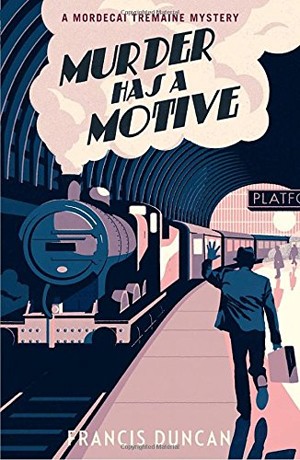
 Written by Francis Duncan — Last December, Vintage began reprinting 1940s classics by Francis Duncan beginning with Murder for Christmas. Murder Has a Motive is one of the latest novels featuring Mordecai Tremaine to appear once again on the shelves. Francis Duncan was the pen name of William Underhill, a man who served in the Royal Medical Corp during WWII, despite being a consciencous objector, and lived, for much of his life in Bristol, where he worked in education. First as a teacher, and then as a college lecturer.
Written by Francis Duncan — Last December, Vintage began reprinting 1940s classics by Francis Duncan beginning with Murder for Christmas. Murder Has a Motive is one of the latest novels featuring Mordecai Tremaine to appear once again on the shelves. Francis Duncan was the pen name of William Underhill, a man who served in the Royal Medical Corp during WWII, despite being a consciencous objector, and lived, for much of his life in Bristol, where he worked in education. First as a teacher, and then as a college lecturer.
Mordecai Tremaine is a retired tobacconist turned amateur sleuth and criminologist. In Murder Has a Motive, he has already enjoyed several successes and has formed a friendship with Inspector Jonathan Boyce of Scotland Yard. Here he travels to the Sussex village of Dalmering to visit his friends Jean and Paul Russell. Paul is the village doctor and when Mordecai arrives, he and his wife are very keen to involve him in a new case.
The book opens with our victim, Lydia Dare, having dinner with her friend, Martin Vaughan. Or, as we are initially told, she’s having dinner with a murderer. Shortly after leaving to walk across the village to her own shared cottage, Lydia is brutally murdered and her body is discovered the following morning. Martin Vaughan was the last person to see her alive so he’s at the top of the suspects list, but with no apparent motive. Lydia was 35 and well-liked by everyone in the village who knew her. She had no enemies, and Vaughan was in love with her. So why kill her? Could it be her imminent marriage to Gerald Farrant, and removal to Scotland?
For much of the book, the focus is on one murder but as Mordecai starts digging around, he finds that there is more going on in this village. Far from being the chocolate box idyll one would expect, there are a lot of hidden secrets lurking under the surface. Are any of them worth killing for? The backdrop for the story is a play that the village amateur dramatics society is putting on. It involves a set of three murders and the first bears similarities to Lydia’s murder. What’s more, Martin Vaughan is playing the killer. Pure coincidence or is someone trying to set him up? With two further brutal murders, Mordecai finds himself looking for a killer who seems to be driven by unbridled rage, with each killing getting more violent than the last.
At 245 pages, this may seem quite a small read but every page is full of descriptive detail, from the characters to the setting. It draws you in effortlessly and the prose whisks you back to the late 1940s, when the book was written. Mordecai himself is a character you instantly fall in love with – a man in his 60s who is interested and enthusiastic about everything going on around him, even down to testing his observational skills in a train carriage by attempting to analyse his travelling companions on his journey down to Dalmering. The description of his personal attributes being a “violent contrast to his carpet slipper body” certainly made me smile in amusement. The fact that he isn’t a policeman and happens to be a friend of the village doctor also means that the villagers are more open to talk to him, even though most of them know he’s a friend of the officer investigating. However, he does manage to underestimate one villager and puts himself in extreme danger in the process.
This book is an absolute delight from start to finish. It’s one of those novels that you can settle yourself down with and completely forget the time because you’ve become so engrossed with the story. There’s a hint of Miss Marple and Father Brown in Mordecai, so if you’re a fan of Agatha Christie and GK Chesterton, then Francis Duncan is most definitely someone you should be adding to your classic crime fiction greats.
Classics in September 2016 is sponsored by Bloomsbury Reader.
Vintage
Print/Kindle/iBook
£4.99
CFL Rating: 5 stars









